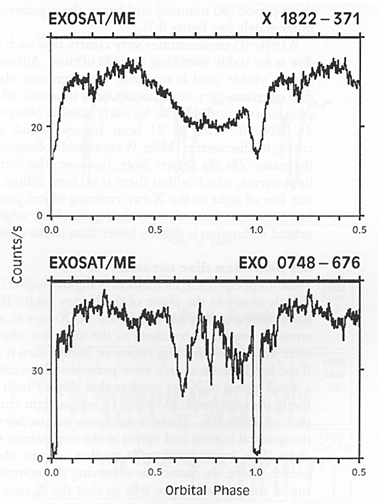Comparison of EXOSAT light curves of 2A 1822-371 and EXO 0748-676EXOSAT light curves of 2A 1822-371 and EXO 0748-676 (bursts removed from EXO 0748-676). Each shows 1.5 orbital cycles for clarity, with phase 0 defined as mid-eclipse. 2A 1822-371 has a partial and broad X-ray eclipse combined with a smooth modulation, whereas EXO 0748-676 exhibits narrow, but almost total eclipse combined with erratic variations. If these are smoothed out (as would be the case if the inclination were slightly higher) then the two light curves are remarkably similar. The erratic variations of EXO 0748-676 are simply due to structure on the edge of the disc occasionally obstructing our view of the central X-ray source. In 2A 1822-371 the central source is never visible at all (the inclination is higher) and so both the eclipse and the modulation are of an extended X-ray region, making the light curve smooth. Diagram courtesy of EXOSAT Observatory, ESA. Reproduced from Charles and Seward, Figure 8-6, Pg. 193.
IMAGES |
By Mission |
Stars |
HEASARC Home | Observatories | Archive | Calibration | Software | Tools | Students/Teachers/Public Last modified: Thursday, 26-Jun-2003 13:48:45 EDT |


